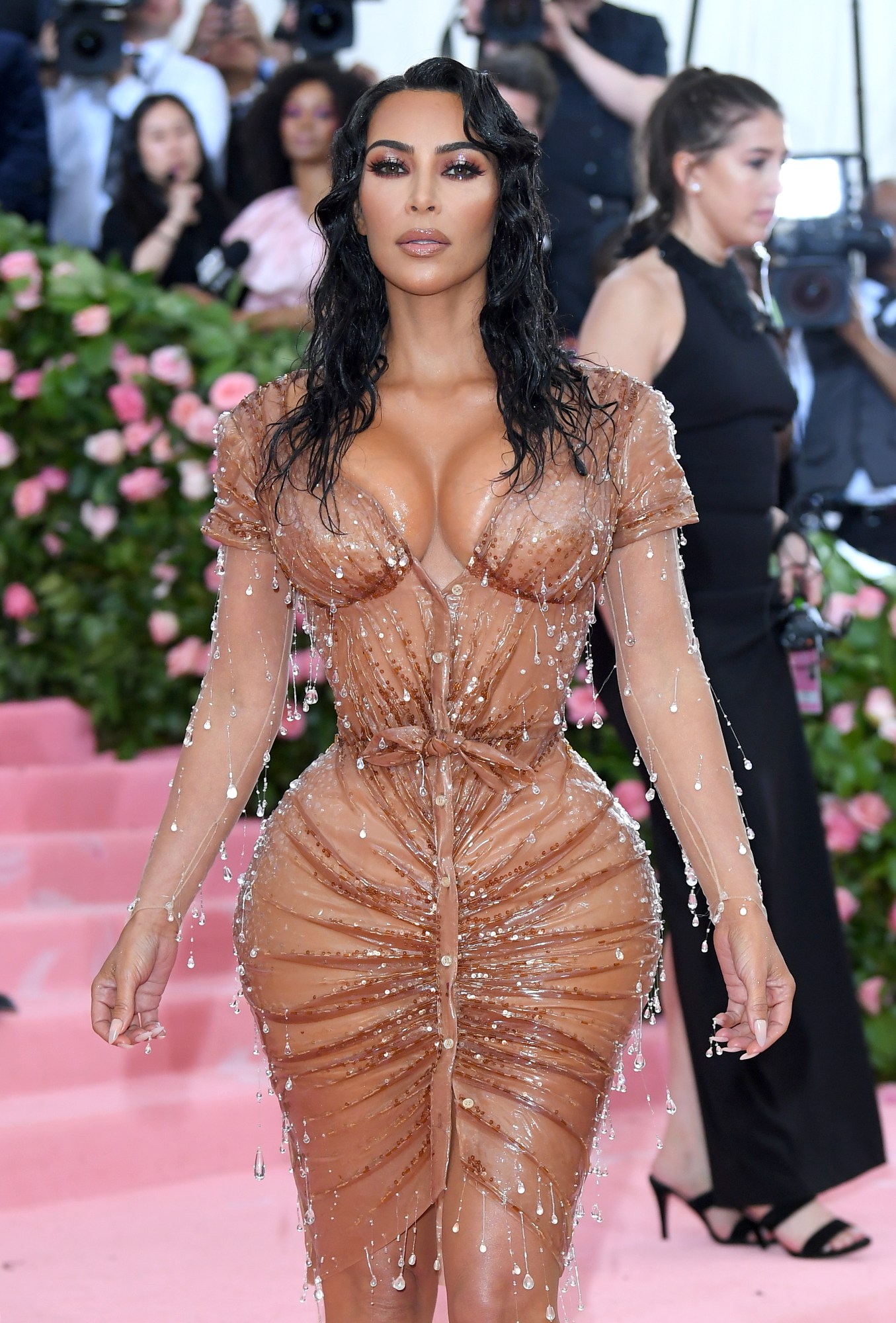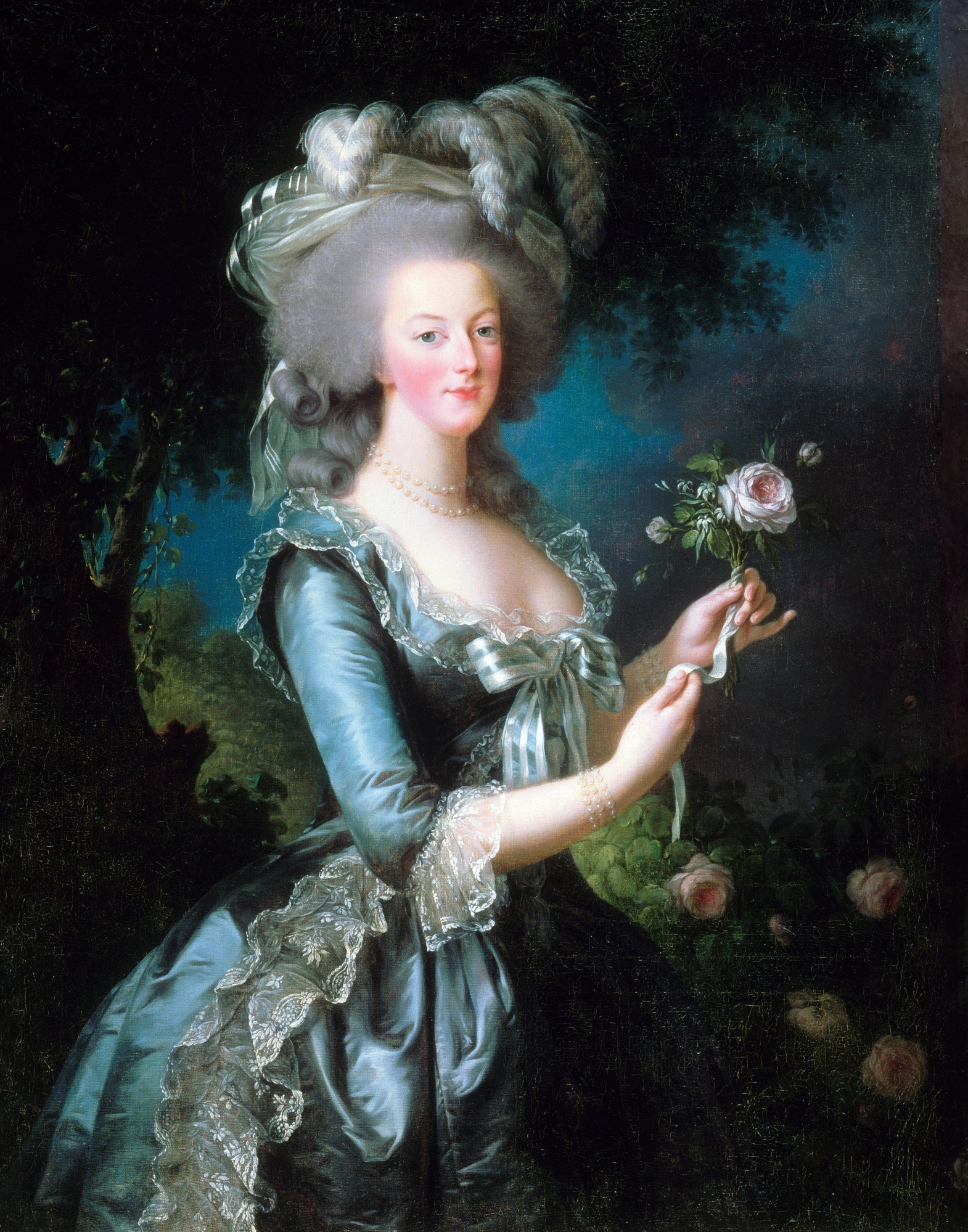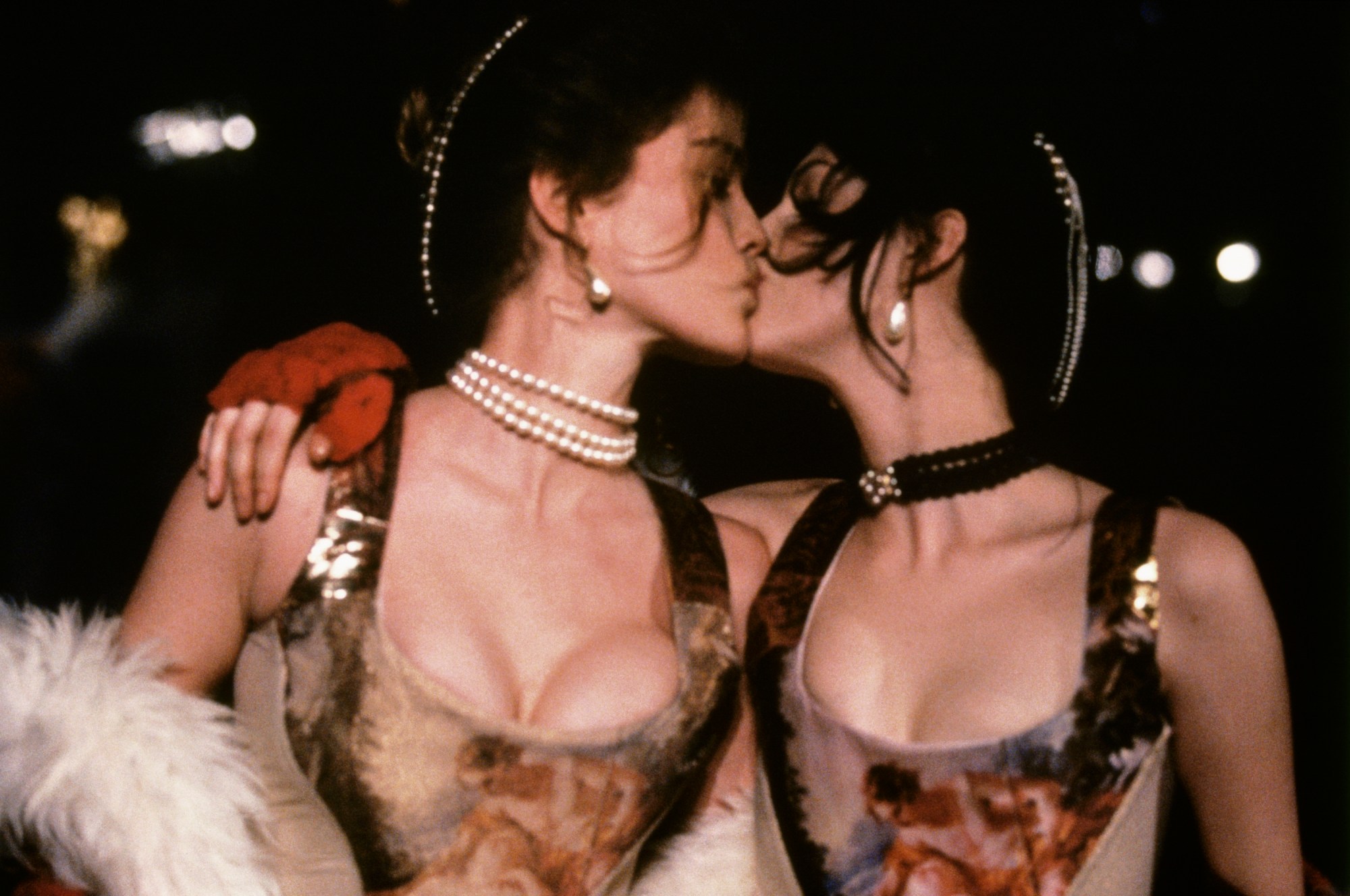It’s 48 hours before the Met Gala and Kim Kardashian-West is being strapped into the final fitting of her Thierry Mugler wet-look dress. And I’m using “strapped in” quite literally, here. As she speaks to Vogue’s cameras about the inspiration behind the look (“[Mugler] is, like, the king of camp”), she’s being laced into a corset by three — count them, three — people. And she looks visibly uncomfortable — eyes glazing over a little bit, letting out vocalized sighs, you can see her mind buffering as she speaks, she’s leaving ellipses between words. “If I don’t sit down for dinner, now you know why,” she tells Vogue, leaning crookedly against the edge of a chair. “I’ll be walking around mingling, talking, but I can hardly sit”. Two months after the gala, WSJ Magazine asked Kim about the infamous wasp-waisted dress. “I’ve never felt pain like that in my entire life,” she answered.

“The corset is probably the most controversial garment in the entire history of fashion,” writes fashion historian — and the world’s foremost corset scholar — Valerie Steele in The Corset: A Cultural History. The garment — a rigid bodice that’s laced to shape the torso — has a tumultuous legacy, to say the least. Perhaps the most polysemous garment of all time, the corset is both adornment and armour, it elicits desire, signifies restraint and performs fashion’s greatest magic trick, the transformation of the body; it’s been both sculpting and forming itself to female ideals of beauty since the 1500s. Throughout its history, the corset has been reviled as an “instrument of torture” by 16th century doctors and 20th century feminists alike (and many in between), for the ways it’s deformed the body and impeded upon women’s personal freedoms. Despite this, the garment has emerged as one of spring/summer 20’s most ubiquitous trends. Why?
The corset, as we know it now, emerged in the 1500s, though iterations — made from soft canvas and iron, even — date back to antiquity. These 16th century corsets, also known as “stays,” are the familiar boned bodices seen in a Shakespeare adaption or, perhaps, a Keira Knightley costume drama, laced up the back, and crafted from rigid materials like horn, buckram and most famously, whalesbone. Discipline — both mental and physical — was a virtue to members of the era’s European elite; bodily control manifested in the form of the corset, which was worn by women (and some men) to hold the body erect, to improve posture but also, to posture. To the nobility, corsets were meant to be constricting: after all, their class valued self-control above all.

Most evidently, women wore corsets to meet the beauty standards du jour. In the 16th century, the look was an elongated, conical torso, with the stays extending to the hips. The 1700s favored short, hourglass silhouettes. And in the 19th century, tight bodices pushed the breasts up and out, to form an S-shape. The common denominator was a small, pinched waist. And women suffered for it. The stylish Georgiana Duchess of Devonshire described the discomfort of a corset in the 1778 novel The Sylph: “my poor arms are absolutely sore with them; and my sides so pinched! But it is the ‘ton’; and pride feels no pain.” In the same century, poet Elizabeth Ham referred to them as “very nearly purgatory.” It’s true that corsets deformed the ribs and misaligned the spines of their wearers. In the 16th century, surgeons alleged that stays could cause respiratory disease, suffocation and sudden death. And while these claims, along with myths of women having ribs surgically removed to achieve a thinner waist, are false, even moderately tight corsets restrict respiration, leading to palpitations, shortness of breath and fainting.
Not surprisingly, advancements in women’s emancipation lead to the undergarment’s demise. French couturier — and famous corset hater — Paul Poiret proclaimed the fall of the corset (in the name of Liberty) at the beginning of the 20th century. By the event of World War I, as women entered the workforce, the garment fell out of favour, for good. Well, almost.

In 1987, British designer Vivienne Westwood revived and revolutionized the corset, turning the garment inside out — literally. In true Westwood parody, the anarchical designer’s autumn/winter 87 “Harris Tweed” collection poked fun at the frumpy prudishness of British nobility, transforming their stuffy, traditional textiles (Harris Tweed) and garments (corsets) into glamorous garb. Westwood named the collection’s corsets — which would become her signature piece — the “Stature of Liberty,” and liberating they were. Unlike the body-modifying, rib-crushing bodices of yore, Westwood’s confections were purely decorative in nature, constructed with lycra panels and zippered backs. They raised the bosom, but let the wearer breathe. More importantly, they were the first corsets to be worn as outerwear. Suddenly, what was once a symbol of female oppression became the uniform of third-wave feminism, a cheeky symbol of women embracing and owning their sexuality. Of the corsets, the designer told L’Officiel, “[They look] great flat-chested or with your dumplings boiling over.”
The corset, for Madonna, was a similar type of power move. On the first night of her 1990 Blond Ambition tour, during the concert’s opening number, the singer ripped open a zoot-y pinstriped blazer to reveal that cone-breasted satin corset — you know the one. It was a move that echoed, cementing Madonna’s legacy as the foremost pop star, and as a pop culture icon. But how did one garment cause such a shockwave? Unlike Dame Westwood’s busty designs, the Jean Paul Gaultier-designed bodice weaponized the female form, transforming its sinuous curves into spikes that seemed to prick. The look was assertive, intimidating; it symbolized a woman in complete control of her sexuality, and dominant, even. Wearing the JPG corset (over a pair of pants, I might add), Madge danced, simulated masturbation, and thrusted her hips as she sang, “You’ve got to make him express himself.”

By the time the mid-90s rolled around, the corset had taken over the runways of Europe. Think early John Galliano, famous for his history-plundering designs, who used the corset to tell the lush, fantastical fashion narratives that would define his career. The British designer’s spring/summer 93 collection, titled “Olivia the Filibuster”, told a tale of shipwrecked swashbucklers; models swaggered and swayed down the catwalk in corseted leather jackets and striped bustiers. For his autumn/winter 93 collection, about a runaway 19th century Russian princess, Galliano sent Kate Moss tearing down the runway in a billowing hooped skirt and corset to match.

And, of course, think Mugler. What was the 20th century corset renaissance without the king of camp, the master of catwalk showmanship, French couturier Thierry Mugler? He’s responsible for not only some of the 90s most iconic runway moments, but some of the most audacious looks of all time. And nowhere is this embodied more, perhaps, than look 101 of his autumn/winter 95 couture spectacular. Like an Arthurian knight from the future (or a cyborg from the past), German super Nadja Auermann stepped out in a golden hard-bodied corset dripped in rhinestones, and with matching articulated sleeves. And although the legendary designer officially retired in 2002, his extreme designs — and extreme corsets — live on into the now, under the creative directorship of Casey Caddawaller. The newly-appointed Mugler designer has resurrected his predecessor’s predilection for the waist-snatching garment into some of the zeitgeist’s most memorable fashion moments. Bella Hadid opened the house’s spring/summer 20 show in one of the season’s sexiest and most viral looks: a mesh corset, styled with a teensy blazer and no pants.
Perhaps more subversive a statement than even Madonna’s Gaultier cone bra, the 21st century’s most iconic corset moment arrived on June 1, 2015. Caitlyn Jenner appeared on the cover of Vanity Fair, in true covergirl fashion, mane tousled, head coyly cocked to the side, and wearing a sumptuous silk satin bodice. The look was an ode to the pin-ups of yore — namely Playboy’s first cover star, Marilyn Monroe, herself — and a powerful way for the trans trailblazer to claim space and express her new gender identity.

But no one living today knows the corset as intimately as Keira Knightley. The actress, herself, has become synonymous with the period drama, the type of historical film in which you might spot a stay or two. The genre, itself, is both the largest proponent and detractor of the corset. Think Kirsten Dunst in Sophia Coppola’s Marie Antoinette, her cleavage iced, like one of her three-tier cakes, in pale yellow silk, pink ribbons, and ruffles and ruffles of lace. Likewise, seeing Glenn Close’s buoyant boobs in Dangerous Liaisons might make us want to strap into one of the near-lethal undergarments, ourselves. Nearly — because what’s a great period drama without a boudoir scene to shatter the illusion. Who can forget the image of Viven Leigh as Scarlett O’Hara, elbows around a bedpost, being laced into her stays. Or Knightley as Elizabeth Swann, gasping, as two chamber maids tighten her laces. A few scenes later, out of breath and feeling faint, she plummets from a castle turret into the gnashing sea below. Knightley has donned a corset on the sets of nine different films. A corset connoisseur, her review of the garment: “positively awful.”
While many credit Prada’s autumn/winter 16 collection — its centerpiece a half-laced white canvas body — for the most recent resurgence of the garment, it was Sydney-based indie label Daisy who ushered in the corset’s most recent renaissance. A millennial riff on the milkmaid fantasy, the mark’s spring/summer 15, “Pure Country” collection, offered a selection of broderie anglaise dresses, laced from sweetheart-neckline to hem, alongside leather underbust corsets and other down-home-hot bustiers, printed in gingham or crafted from calf-hair. The look, according to the label, was everyday eroticism, a bubbly, quotidian sexy that demonstrated the quintessential it girl fit could transcend ripped jeans and a band T-shirt. The movement went viral, with the zeitgeist’s batch of Insta-girls — from Kendall Jenner and Bella Hadid to Petra Collins — decked in corseted, micro-mini prairie dresses, all laced loosely, effortlessly up the front.
The corset disappeared from women’s wardrobes in the 20th century, but the ideals it spawned — damaging or not — live on. In place of a boned bodice, women have internalized the corset through diet, exercise, cosmetic surgery, digital retouching, flat tummy tea. The list goes on. It’s really no surprise that into the 2010s, the corset — in its true, functional form — has made a return. In the era of instant gratification — movies and music at a single click, the ability to transform your (digital) body with a few flicks of the Facetune app — why wait for the months-long pay off of a workout regiment? Emblems of this Insta-era, the Kardashians began peddling waist trainers — corset-like devices that promise to whittle the waist to a perfect hourglass — as far back as 2014. Since then, health experts have cautioned against the harmful garment, which, at best, rests on unfounded claims and, at worst, causes long-term structural issues. Despite these warnings, the trend has blown up: one model of the waist-shaper has over 3,000 reviews on Amazon. Ironically (or not), the product’s copy leads with the question “Want a sexy figure like Kim Kardashian?”
Two new labels that are bringing corsets back for SS20 are Australian mark all is a gentle spring and Brooklyn designer Kristin Mallison. Following in the footsteps of Daisy, both brands approach the body-cinching piece with a whimsical nostalgia. all is a gentle spring’s signature pastoral corset is printed in a Toile de Jouy pattern, which depicts idyllic scenes from the era of the garment itself. Same goes for Mallison and her viral iterations, pieced together from vintage tapestries and upholstery fabrics, embroidered with elaborate tableaux of 18th century courtship and folly. Both labels, who gained their followings equally through affiliations with already-iconic boutique Café Forgot and the power of social media, have brought the antiquated garment into the digital age, where it thrives. Instagram is all about the flex and the fantasy, and the corset — with its extreme look — brings it, on both fronts.
To some new designers, the corset can be a means of protection, against the barbs of the world’s current political climate. The duo behind British label Charlotte Knowles titled their SS20 collection “Venom”; it’s an offering of what they call “militarized corsetry.” Instead of laces and eyelets, Knowles’ bodies fasten with Velcro and press-studs, like tactical vests; traditional whalesbone and steel rods are replaced with flexible silicone, for combat-ready ease of movement. “Our woman is fighting for her place in the world,” Knowles’ designer partner Alexandre Arsenault told Vogue, “She is tough and dangerous.” Similarly, fellow Londonite Dilara Findikoglu — known for her goth-y, historical garb — dressed Madonna in what she called an ‘armour corset’, in the style of Joan of Arc, for Madge’s 2019 Eurovision performance. After all, a corset’s not that far off from a breastplate.
Of all the designers reviving the corset this season, none are doing it quite like Sinéad O’Dwyer. Cast in silicone, moulded from lifecasts of her muses and friends, O’Dwyer’s bodices actually share very little in common with the traditional garment, save for lacing, the focus on the female form. Whereas historic corsets were meant to eradicate the ‘natural’ body, O’Dwyer embraces it — sagging breasts, cellulite, ‘fupa’ and all. Her designs are a response to today’s narrow ideals of beauty, the very ones that have been shaped by the corset since the 1500s; they’re about opening up a space within fashion for all body shapes and sizes. “My work is a sort of ‘fuck you’, and a declaration of pride in your body. I think it conveys the power that comes from women deciding that they don’t have to accept the status quo,” she explains. “You shouldn’t have to feel compelled to live up to an externally set, arbitrary standard. You should have the control.”



